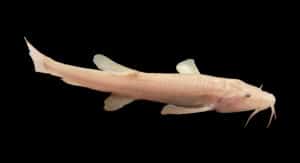 When German diver Joachim Kreiselmaier reached the deepest parts of the Danube-Aach cave system, he couldn’t believe his eyes: a “strange fish,” with a pale body coloration and smaller eyes and larger nares and barbels than the loaches typically spotted nearby. He had discovered the first cavefish in Europe, and the northernmost in the world.
When German diver Joachim Kreiselmaier reached the deepest parts of the Danube-Aach cave system, he couldn’t believe his eyes: a “strange fish,” with a pale body coloration and smaller eyes and larger nares and barbels than the loaches typically spotted nearby. He had discovered the first cavefish in Europe, and the northernmost in the world.
“This is spectacular, as it was believed that the Pleistocene glaciations prevented fish from colonizing subterranean habitats north of 41° latitude,” said ecologist Jasminca Behrmann-Godel of the Limnological Institute of the University of Konstanz, who examined the fish Kreiselmaier brought back to the surface. “Initial genetic studies, together with knowledge on the geological history of the region, indicate that the cave loach population is amazingly young — not older than 20,000 years.”
The mysteries of the new species, Cave barbatula, will now be investigated by Professor Dr. Arne Nolte of the University of Oldenburg, Germany, and Assistant Professor Dr. Fritz Sedlazeck from the Human Genome Sequencing Center at Baylor College of Medicine in Houston, Texas, as part of the 2018 Plant and Animal SMRT Grant.
The grant will provide Nolte and Sedlazeck with access to the PacBio Sequel System at GENEWIZ, as well as the materials needed and bioinformatics support to conduct comparative genomic sequencing on the newly discovered European cavefish.
“This grant enables us to establish the genome assembly of the European cavefish and identify genetic variants from its surface-water ancestors. We are fascinated by changes in the sensory system and pale pigmentation of the fish and we will compare its genomic makeup with the Mexican cavefish which is an important model organism in developmental biology,” Sedlazeck said. “The outcome of this study will enable us to understand the initial steps that lead to the evolution of cave animals and impact our understanding of how multiple phenotypes evolve among vertebrates.”
“The combination of PacBio’s powerful genomics platforms and GENEWIZ’s depth of experience in DNA and next-generation sequencing provides researchers like Drs. Nolte and Sedlazeck the technology and support they require to further their discoveries and understanding of the world around us,” added Dr. Ginger Zhou, Vice President of Global Next Generation Sequencing for GENEWIZ.
June 27, 2018 | Corporate news